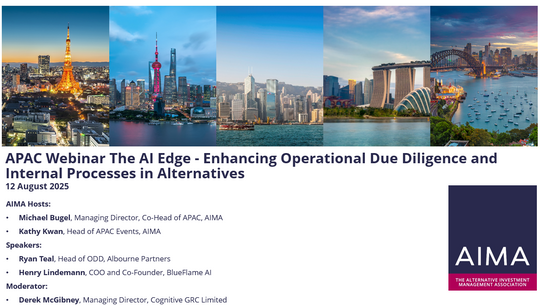The rise of the machines - Fusing AI and legal contracts
By Paul Hands; Ralitza Shiderova; Michael Beaton, DRS
Published: 17 June 2024
In the current legal environment, you can’t have a conversation without mentioning the application of technology. In the world of contract management, software platforms can now create, search, and perform deep-dive analysis into even the most complex agreements. In this new reality, companies are beginning to see that “the old ways” of keeping contracts in PDF format in a folder somewhere or original hard copies in a drawer simply no longer work.
This article discusses Artificial Intelligence (AI), its application to contract management, and why it is in the interests of AIMA members to enhance their capabilities in this area.
A brief introduction to AI
Since the advent of Chat GPT in November 2022, entire industries have embraced the idea of using a machine to learn and streamline processes, optimise conditions, and generally make life easier for workers. The legal world is no different. However, it pays to take a moment to consider just what AI can really do, what it’s good at, and where the potential pitfalls lie.
What is AI (in a nutshell)?
AI in the form that we know it today is effectively a very complicated decision-making algorithm. It is fed with data – a lot of data. At the time of writing, the biggest model, GPT 4 from OpenAI, consumed roughly 10 trillion words whilst being trained. Based on what was said before, an AI model predicts – as accurately as it can – what to say next. Therefore, to say that an AI model can ‘think’ is perhaps a misnomer, although it is easy to get muddied into definitions which this article aims to avoid.
What is AI good at?
AI models are typically brilliant as creative tools. They can write poetry, short stories, and summarise data very well. They can understand human written prompts and answer in a format a human would understand. They can be given context and can be asked to answer in a particular style. In all these aspects they usually do a convincing job. They are already causing headaches in the world of education, as they can answer essay questions – even with a condition of “this should be of a B grade standard”.
What are the dangers of using AI?
In a legal context, detail and accuracy is paramount. Herein lies one of the risks. By their very design, AI models are creative. They actually hallucinate – which is to say that sometimes they might read things in a prompt that weren’t there, go off on a tangent or, as a pertinent example, simply make up non-existent case law in support of an argument. Given this inherent creativity, asking an AI model to draft a negotiation – without a number of constraints and a human eye to exercise quality control – would be a recipe for disaster.
With AI being such a hot topic, it can also be difficult to determine if a Software as a Service (SAAS) solution advertising AI is simply dressing automation in the cloak of genuine machine learning. If a model is 100% accurate, chances are that it’s a very involved bit of automation code, rather than a genuine utilisation of AI. In itself, this isn’t necessarily a bad thing. However, being aware of the different limitations a system like this has (not being able to adapt to changes in the underlying data being of primary concern) is important for companies when deciding which SAAS solution to go for.
Why is this relevant to you?
Time is money
Processes that are repeated multiple times, without the use of technology to speed them up and minimise human error, cost companies in a very real sense. Think about it in the context of contract management. How much time do you spend looking to find relevant agreements (and then understanding what they say), analysing risks every time an external event occurs or threatens, and drafting the same agreement or reviewing the same basic comments time and again? That time – that money – could have been put to better use.
Technology is rapidly addressing that problem. New SAAS solutions exist that can streamline the creation, amendment and negotiation of contracts, the digitisation of executed versions and the analysis of risks and commercial opportunities that can otherwise lie hidden within portfolios of documentation. This shift has happened relatively recently, but the rate of improvement is increasing all the time. Moreover, collaborative industry efforts to create common communication models between systems (such as ISDA’s “Common Domain Model”) will only further accelerate the process.
Data is king
Subject matter expertise and knowledge can only go as far as the data to which it is applied. Herein lies the nub of the problem – efficient acquisition of relevant data. High quality data is of paramount importance. Yet it remains one of the biggest hurdles faced in adopting new technology. On a micro level, understanding and communicating the obligations, risks and opportunities associated with a small set of contracts is a task that can be accomplished by a single qualified practitioner. However, even for those firms without budget or resource constraints (a unicorn indeed!) this is not a scalable approach. Absent technology, the problem becomes exponentially harder as you attempt to adopt a business-wide approach.
Fortunately, this is an area in which AI can really drive progress. Instead of dedicating teams to extract legacy data, it’s entirely feasible to create a system that takes a document and extracts the data immediately and accurately, with little more than a cursory check from a human eye. The time savings – the cost savings – the benefits which naturally flow – are huge.
Once good quality data has been acquired, it becomes a relatively trivial exercise to generate a macro view of the contractual risks, obligations and opportunities facing the firm. What of the other benefits which naturally follow? Well, the burden associated with audits reduces. Levels of regulatory compliance increase. Looking above the line, the holy grail of understanding how to optimally allocate each asset of the firm at any point in time comes one step closer. More recently, the demonstrable power of data has even become a focal point for sales conversations.
In simple terms, when applied correctly, technology can help you to acquire information as a source of regulatory compliance and competitive advantage – providing insight, hindsight, and foresight into all of your commercial relationships. It’s all there for any firm willing to take the plunge.
So, what’s holding you back?
We’ve seen this movie before. Issues arise that could be solved by technology. Despite this, there remains a reluctance (a fear?) to change something that has worked for a long time – even though nobody is quite sure HOW it works. All that is known is that the current approach is far from optimal and getting worse all of the time. Tactical patches are applied to interim solutions sitting on top of strategic problems. Inertia rules.
But times are changing. If you don’t want to adapt, at least know that someone else is – and they are gaining a competitive edge in the process. And size is no longer an excuse. For sure, larger institutions may have the budget and patience to create an in-house technology solution. However, history questions the wisdom of expending precious resource and even more precious time in building and maintaining solutions which are key, but not core, to the business. Far better, to acquire capabilities from suppliers who are invested in developing and supporting solutions for the long-term. Whisper it, but you no longer need the deepest of pockets to access game-changing technology. You just need the will to embrace it.
The future is now
The technological leaps over the last decade have been felt across every industry, including that of the legal documentation. The advent of AI and its mainstream use has turbocharged the rate of change. Companies that position themselves well in this ecosystem and adopt technological solutions to optimise processes, will have a distinct competitive advantage in the years to come. Those that do not will inevitably decline.
Visit DRS - Alternative Legal Solutions (drs-als.com) for more information.
With AI being such a hot topic, it can also be difficult to determine if a Software as a Service (SAAS) solution advertising AI is simply dressing automation in the cloak of genuine machine learning. If a model is 100% accurate, chances are that it’s a very involved bit of automation code, rather than a genuine utilisation of AI.








